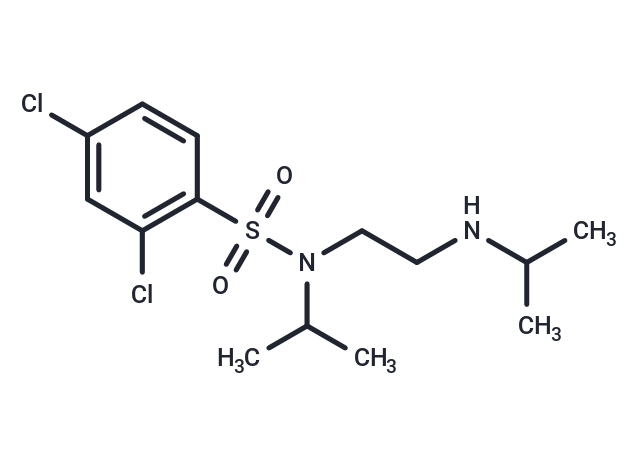Shopping Cart
- Remove All
 Your shopping cart is currently empty
Your shopping cart is currently empty

RN-1734 is selective TRPV4 channel antagonist(IC50 of 2.3 μM,5.9 μM,3.2 μM for hTRPV4, mTRPV4 and rTRPV4,respectively)

| Pack Size | Price | Availability | Quantity |
|---|---|---|---|
| 10 mg | $41 | In Stock | |
| 25 mg | $83 | In Stock | |
| 50 mg | $131 | In Stock | |
| 100 mg | $205 | In Stock | |
| 200 mg | $295 | In Stock | |
| 1 mL x 10 mM (in DMSO) | $29 | In Stock |
| Description | RN-1734 is selective TRPV4 channel antagonist(IC50 of 2.3 μM,5.9 μM,3.2 μM for hTRPV4, mTRPV4 and rTRPV4,respectively) |
| Targets&IC50 | TRPV4 (mouse):5.9 μM , TRPV4 (rat):3.2 μM, TRPV4 (human):2.3 μM |
| In vitro | In vitro, RN-1734 treatment clearly inhibited the influx of calcium and decreased the levels of IL-1β and TNF-α in lipopolysaccharide (LPS)-activated microglial cells by suppressing NF-κB P65 phosphorylation.?Apoptosis of oligodendrocyte induced by LPS-activated microglia was also alleviated by RN-1734.?Activation of TRPV4 in microglia is involved in oligodendrocyte apoptosis through the activation of the NF-κB signaling pathway, thus revealing a new mechanism of CNS demyelination[1]. |
| Cell Research | LPS-treated microglial cells were further divided into a LPS group, a vehicle (DMSO treatment) group and a RN-1734 group.?The cells were treated with 1 μg/ml LPS (Sigma) or RN-1734 (10 μM) for 3 h .?Next, the cells were triple-washed with DMEM medium to remove LPS, and then incubated in DMEM with or without RN1734 for 24 h. Finally, the cells were collected for TRPV4 immunocytostaining, and the supernatant was collected separately for enzyme-linked immunosorbent assay (ELISA) or for the oligodendrocyte apoptosis experiment.?The supernatant of the microglial cells was mixed with DMEM/F12 at a ratio of 1:1.?The mixed medium without LPS was used for the control (Ctrl) group, the medium with LPS only was used for the conditional medium (CM) group, and the media with LPS and DMSO or RN-1734 were used for the CM-vehicle group and the CM-RN1734 group, respectively.?After oligodendrocytes grew for 2 days in 6-well plates in DMEM/F12 containing 10% FBS, the differentiation medium was replaced with the described Ctrl or different CM media for 24 h. Then, the cells were harvested for apoptosis analysis and western blot analysis separately[1]. |
| Molecular Weight | 353.31 |
| Formula | C14H22Cl2N2O2S |
| Cas No. | 946387-07-1 |
| Smiles | S(N(CCNC(C)C)C(C)C)(=O)(=O)C1=C(Cl)C=C(Cl)C=C1 |
| Relative Density. | 1.228g/cm3 |
| Storage | Powder: -20°C for 3 years | In solvent: -80°C for 1 year | Shipping with blue ice. | |||||||||||||||||||||||||
| Solubility Information | DMSO: 10 mg/mL (28.3 mM), Sonication is recommended. | |||||||||||||||||||||||||
Solution Preparation Table | ||||||||||||||||||||||||||
DMSO
| ||||||||||||||||||||||||||

Copyright © 2015-2025 TargetMol Chemicals Inc. All Rights Reserved.